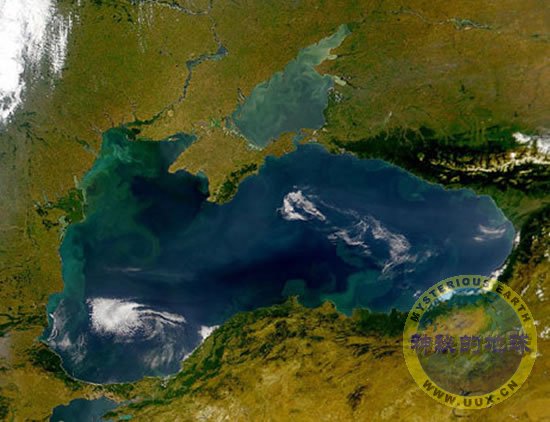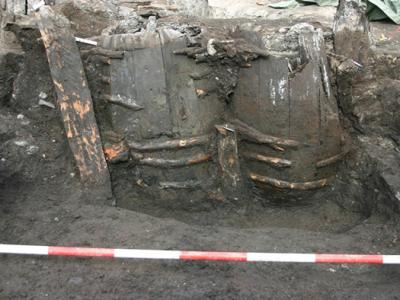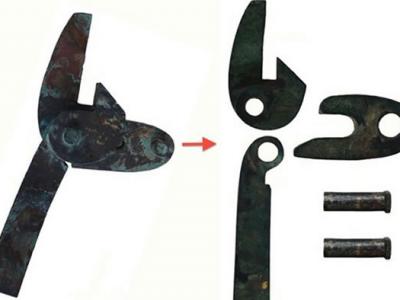"Noah's Flood" May Have Triggered European Farming
The Black Sea on a clear day is seen from NASA's SeaWiFs, a specialized sea-viewing satellite, in an undated image.
New research suggests the biblical story of Noah's flood may have been inspired by a catastrophic flood more than 8,000 years ago.
Around this time the North American ice sheet melted, raising sea levels and flooding the Black Sea.
The deluge may have also spurred a growth in agriculture in Europe, experts say.
Image courtesy NASA's SeaWiFS
Anil Ananthaswany
for National Geographic News
November 20, 2007
The flood that is said to have inspired the story of Noah's Ark may also have sparked the rapid rise of agriculture in Europe, a new study says.
Scientists have speculated for some time that the biblical account of Noah's flood was rooted in a real event thousands of years ago.
One theory is that it could have been a flooding of the Black Sea, an inland sea wedged between southeastern Europe and the Anatolian peninsula. (See a map of Europe.)
Such a flood could have been caused by the melting about 8,000 years ago of a gigantic ice sheet that once covered most of North America.
The deluge may have also contributed to an explosion in European agriculture—especially throughout inland regions near the Black Sea, where farms were previously scarce, the researchers found.
Dating the Flood
In 1997 geologists William Ryan and Walter Pitman of the Lamont-Doherty Earth Observatory of Columbia University in Palisades, New York, argued that the Black Sea had once been a freshwater lake.
Then, as the last ice age ended and sea level rose, the Mediterranean Sea surged over a strip of land known as the Bosporus sill, which is part of modern-day Turkey, and into the Black Sea.
The geologists based their controversial claim on sonar maps, which showed old shorelines buried beneath the mud, 295 to 328 feet (90 to 100 meters) below the surface of today's Black Sea.
They also found perfectly preserved dunes, suggesting that submergence had been quick, as well as freshwater and marine shells in mud cores.
In the new study, researchers looked at the ages of the youngest freshwater shells and the oldest marine shells found in mud cores.
They used the data to pin down the Black Sea's supposed transition from fresh water to salt water to about 8,300 years ago.
"That's the same time [that] there was a big catastrophic release of fresh water from North America," said study co-author Chris Turney of the University of Exeter in the United Kingdom.
Toward the end of the last ice age about 12,000 years ago, the massive Laurentide ice sheet that had covered most of North America began melting to form a gigantic lake.
When the ice gave way entirely, the lake emptied into the North Atlantic Ocean, causing sea level to rise by about 4.92 feet (1.5 meters).
"It looks like it was the straw that broke the camel's back," Turney said. "It was enough to get the Mediterranean over into the Black Sea."
Geologists had previously dated the release of fresh water into the North Atlantic Ocean to between 8,100 and 8,500 years ago.
"Our age [for the Black Sea flood] fits in very nicely, bang in the middle."
(Related news: "Noah's Ark Discovered in Iran?" [July 5, 2006].)
Boost to Farming
The flood seems to have kick-started agriculture in Europe, Turney said.
After farming had spread from the Near East to southeastern Europe about 9,000 years ago, the growth of agriculture in Europe had inexplicably slowed.
When Turney and colleague Heidi Brown of the University of Wollongong in Australia looked at the dates for the expansion of farming throughout Europe, they found an intriguing link.
"As soon as the flooding happened, what we see in the dates is a massive acceleration [in farming]," Turney said.
Hunter-gatherers who were living on the coast of the Black Sea before the flood moved into the interior areas, only some of which were being farmed at the time.
The new analysis showed that the number of sites in the coastal and inland regions of the Balkans grew rapidly from about 8,200 years ago to about 7,300 years ago.
The research was published recently in the journal Quaternary Science Reviews.
Alternate Hypothesis
Geologist William Ryan, who proposed the freshwater lake idea in 1997, said that the accelerated expansion of European farming needs an explanation.
"But I would say that the Black Sea flood is just one hypothesis," he said.
Ryan has another: Toward the end of the last ice age, the rate of sea level rise was dramatic.
Estuaries at the mouth of rivers were being flooded. When the ice age ended, the rate of sea level rise slowed, and for the first time, rivers started meandering across the flood plains.
This gave farmers access to soils fit for farming—which coincided with an explosion in farming across Europe.
"That's a possibility, and it's linked to sea level," Ryan said.
Regardless of what brought on sea level rise, the flooding of the Black Sea would have disrupted the lives of people living on its coast, a historical event that serves as a warning for the future, Turney said.
"There are 145 million people worldwide living within a meter [3.2 feet] of the sea level today, mainly in the developing world," he said.
"It shows that we have an obligation to sort [out] this mess that we are creating at the moment with climate change."












